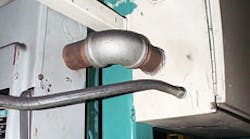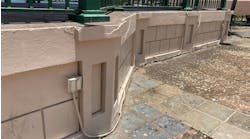How well do you know the Code? Think you can spot violations the original installer either ignored or couldn't identify? Here's your chance to moonlight as an electrical inspector and second-guess someone else's work from the safety of your living room or office. Joe Tedesco, who has a knack for finding shoddy electrical work, did the dirty work and found this mess. Now it's your turn to identify the violation.
Find the Answer
Answer:
Plumbing fittings can’t be used for electrical installations. You must use electrical conduit for this type of installation. A lack of locknuts on the outside and inside of this installation presents a bonding problem.
The following 2005 NEC rules are just a few that can be cited for this installation:
Per 300.10, “Metal raceways, cable armor, and other metal enclosures for conductors shall be metallically joined together into a continuous electric conductor and shall be connected to all boxes, fittings, and cabinets so as to provide effective electrical continuity. Unless specifically permitted elsewhere in this Code, raceways and cable assemblies shall be mechanically secured to boxes, fittings, cabinets, and othe enclosures.”
Per 110.8, “Only wiring methods recognized as suitable are included in this Code. The recognized methods of wiring shall be permitted to be installed in any type of building or occupancy, except as otherwise provided in this Code.”
Per 250.4(A)(3), “Non–current-carrying conductive materials enclosing electrical conductors or equipment, or forming part of such equipment, shall be connected together and to the electrical supply source in a manner that establishes an effective ground-fault current path.”



